
Riding the Wave: Adidas, Assessment, Mexico, the Iyengar Centenary Intensive, and Geetaji.

Riding the Wave: Adidas, Assessment, Mexico, the Iyengar Centenary Intensive, and Geetaji.
NOVEMBER 12, 2018
“Yoga should not be taken lightly, as if it were a hobby. It should be approached with faith, enthusiasm, determination, keenness, courage, will, and dedication.” -Geeta S. Iyengar

Nothing but Divine hands could have sculpted the incredible unfolding of my life the last few months. Leaps of faith, clarity, fear and the going beyond fear has led me to experience four big life events in such a short period of time, and way they relate feels so meaningful and in retrospect, perfect.
As I wrote much of this on the airplane flying towards home last December, a 40 hour haul, I could feel my heart drawing closer to my sweet kids, and iven who I missed intensely. It felt so good to be homeward bound, and now, home at last! But this journey was essential for me, as Geeta would say, ‘and that is a fact.’ It’s as though a candle I’ve been building inside my heart, preparing for years through practice, discovery and study, was lit by Geetaji’s presence and teachings. The wick caught right away. I burns clear and bright inside me. This one chance, an ignition, and an unexpected farewell as well. In her presence my world shifted, and as she flew free from her body, my world shifted again. What a thing, to travel so far, to receive so much, and then say goodbye forever, in one massive celestial feel swoop.
From the surprise and cosmic encouragement of an Adidas yoga modeling gig in LA, to the initiation of my first Iyengar Assessment a few weeks later, to the magical week teaching, playing, and returning to wholeness in Mexico with Zoreh at our Troncones Yoga Retreat, to this irreversibly profound trip to Pune, India for the Iyengar Centenary Intensive, these events all opened my mind and heart in deep ways. To have them all strung together, pearls on a relatively short linear time string, feels meaningful too. Guruji said, ‘God is like the back, you cannot see God, but you can feel God.’ I’m definitely feeling divine forces, at work, and whatever the purpose is at play, I have total trust in it.
Really each of these could have been it’s own post, but the pace of life is a fast current these days. So here it is, all together. It’s a lot… but in case you’re curious, here it is.
~~~
The morning of December 16th, while I was sleeping, just a few blocks away, beloved Geeta S. Iyengar peacefully passed out of this life. I heard she was in a yoga pose to help her breathing, surrounded by family, and like that, the last breath left. (I admit, I can’t help but wonder, what was the pose? Which props supported her…) The previous two weeks, I had been in that massive group of 1,300 students from all over the world -56 countries- gathered for the Centenary Intensive in Pune, India to celebrate and honor the life and legacy of Geetaji’s father, Yogacharya BKS Iyengar, AKA Guruji. He would have turned 100 on Dec.14th. (More on that below!)
It’s as though all these years I was building a candle inside my heart, and brought it unknowing, and through Geetaji’s teachings, it’s been lit. The wick caught right away. It burns clear and bright. My world shifted. Then Geetaji died, her work here done, no abhinivesha – and my world shifted again.
Who am I, to have placed a final kiss at her feet, wrapped in pure white? To travel so far, to receive so much and then say goodbye forever, all in one massive celestial fell swoop?

Last summer, I was kiiiiind of contemplating going to this Centenary Intensive in Pune but it felt like a fantastical dream, totally beyond my grasp financially and logistically. Still, I couldn’t let it go. At Patricia Walden’s retreat in CO, Brian said, ‘It might be your last chance to study with Geeta…’
I’ve admittedly struggled with regret about not making it happen to study directly with Guruji while he was alive. Little kids, little money, so much has played out. I know my life has unfolded perfectly, though, and in fact over time my regret has been replaced by a deep gratitude and different connection, that is both intimate and real. There’s so, so much to work with. But I knew I didn’t want to miss being in Geeta’s presence. I knew she wasn’t teaching much, and that I wanted to receive that teaching.
Months passed. I pretended to let go the idea to go to India, so many practical reasons. I began to plan a local 100 days of yoga and Centenary event. But then an incredible opportunity came my way. I had been doing some prosperity work, prayers, tithes. Adidas contacted me with an out of the blue gig. They flew me out to LA in early October for a week and I was caught up in a glamorous swirl of modeling yoga clothes, bringing queer yoga essence, and connecting with some other amazing women who are doing yoga projects in their communities: bringing yoga to black, brown, poor, queer, HIV+ folx, you know, the people not represented in glossy yoga magazines and who often are missing from the average yoga class. It was an affirming and eye opening trip. Not only was it meaningful and fun, but it paid a nice little chunk of cash that I realized I could use for India. OMG.
Adidas
A bit on that week in LA, which left me spinning, glowing, exhausted but awake to new potentials: The Adidas Wanderlust photo shoot. I’m going to be one of the featured models for their 2019 spring yoga clothing line ads. They invited 5 women; I absolutely loved getting to connect with the wise, witty, inspiring Ali, Abby, Sinikiwe, and Tie. We get to be featured on The Stance podcast, an award-winning arts, culture and current affairs podcast exploring diverse global perspectives. Stance creators Chrystal Genesis and Heta Fell, and Jackson are amazing and I loved getting to connect.
I’ve never been part of such a big production, a mass of directors, crew, glam team, stylists, lighting etc swirling around… abundant project budget and resources. Top secret outfits! (The actual shoot photos will be released this spring.) Gorgeous catering but no time to sit and eat. I was centered in the reality that in moments when the external whirlwind is strong, it demands and requires me to go inward, so that I can bring clarity of purpose out to the world. To serve in ways I’m still learning to see. I want to be a conduit for resources to flow into my community, for the teachings of Iyengar Yoga to flow out into the world to those who need it most. It did feel good to be a ‘real’ queer yoga body in a picture. Everyone worked so hard. The whole team was amazing. It left me excited about funding, expanding networks of support, and a broader vision of what it means to serve the struggle for healing and transformative justice, equity, activism through yoga. That there are initiatives out there to help make “yoga for everyone.”
Naturally even in a project that seeks to uplift queer // women of color, the residues of imbalance and privilege still wove their way through…I was left mulling over, what does sponsorship do to struggle, and who bears the cost, and how…? I’m very curious (um, anxious!) what will be sliced diced and used out of all the content collected. How does commercial work like this fit into the bigger picture of real healing and change? There’s so many people, black brown indigenous poor queer trans disabled and otherwise invisible-ized marginalized people at a grassroots level making something potent and important out of nothing or very little. I think about how a little money can go such a long way in grassroots organizing… how to be a bridge for support to flow in.

Assessment
A couple weeks later I flew out to CA again for Intro 1+2 Iyengar Assessment. After several years of wanting and preparing to go up, finally the weekend arrived. After many steps, much study, I made my imperfect offering, and to be honest, all though it was freaky to observe my nervous system on its wild trajectory throughout the process, my heart delighted in rising to the occasion. It felt like I was there to show I deeply I care about this subject/ practice and that I’m a worthy student. A worthy teacher, well that is another matter!

It’s good for humans, I think, to have something terrifying and deeply meaningful that requires perseverance, faith, and that we bring our very truest essence and heart to it. Something worthy of pouring everything into it. That requires it. To overcome fear and doubt, to walk through fire and emerge welcomed and victorious. This process could look many ways, and I’m so glad I’ve found it on this path of yoga sadhana (spiritual practice) in the brilliant, resplendent and arduous lineage of Iyengar Yoga. I’m really grateful for the structure of assessment, and the support it provides in helping students/teachers of Iyengar yoga grow within a system of progression, accountability, and depth. The intense process of preparation and the high standard of the Iyengar method is brilliant, I’m so grateful it’s here for me, for us, to help us grow, awaken!
I had a dream in the fall of 2017 that I was in an assessment teaching utthita trikonasana, and Guruji was my assessor! I was teaching a point Abhijata taught at the 2016 convention, and I glanced over to see what he thought and he looked at me and said ‘don’t think about yourself, put your attention on the students!’ I woke up with a clarity, like, 2018 I’m going up, I’m going to make it happen. I signed up for Craig and Leslie’s teacher training in Denver that day.
I came to this path circuitously over many years of practice, periphery to the core. Wonderful teachers gradually brought me to know what is yoga, and clues revealing the Iyengar legacy. Initially I studied with teachers that had left the system, they eluded to certified Iyengar teachers and I thought of CIYTs as some faraway superstars; the process remained shrouded in mystery, elusive, seemed not meant for me, especially since there was no one local to ask or work with. There has been so much taking a step into the unknown without knowing where my foot would land. It was 2014 that I decided I wanted to become a CIYT but there were many stages within to go through, journeys inside and out in the world to take. Many times I needed to get out of my own way.
Needless to say, it all went well. I’m so glad to have Leslie, Craig, Patricia, Bobbie – teachers who can clearly show the ways to understand, refine and go beyond what’s familiar. I yearn to serve more effectively.
Through the discussion sessions at the Centenary Intensive it sounds like how teacher trainings and assessments are run differs greatly in different countries, and finding a way forward that develops depth of practice, maturity and sensitivity rather than mechanical rigidity, that is workable and fair, is a large discussion. Even though the system is imperfect, I think that teacher trainings and having diverse forms of mentorship are extremely valuable, and I hope they can continue to meet the wide variety of candidates. Needless to say, though the immense nervousness and stress involved was a lot to experience, it was an incredibly meaningful and affirming initiation. A bit like a wedding — in a good way! Like, after years of commitment, a ceremony that makes it official. Except, instead of a party, a giant weekend of intense testing. Ha. And now, here I am at the beginning, again.
Mexico
As soon as I landed home, the pull of life’s river swept me into her rapids; parents in town, remodeling, teaching too much and generally I didn’t have time to catch my breath. In anticipation of being gone, I savored with a palpable bittersweetness the precious time with my kids, Io (13) and Kota (22 months). I’ve never been away from them so long. Before I knew it my partner iven and I were up at 4, driving through the cold dark night to the airport to board flights to Mexico. Landing into the gorgeous natural abundance of the land and ocean in Troncones was like a healing balm to my frazzled spirit. Much needed spacious connection with iven and days that unfolded in a slow, vibrant perfection washed away months of stressful hustle. (Well, despite as Zoreh later called it, the ‘blood sacrifice of 3 kisses from God,’ three stitches for iven’s sweet head from a beach mishap on day 1 that meant an adventure into a Zihuatanejo hospital…!)
If you’ve never been to Troncones, it’s an incredibly magical place. Really – you should come with us next next year! Zoreh had the vision 20 years ago to build a Yoga Retreat center near this vibrant and off-the-beaten-path fishing village, and by now she has the rhythm of retreating down to a smooth, graceful glide. We had a blast. I kept finding myself amazed at the sweet moments that unfolded: the surrender of the ocean with it’s perfect clear blue green waters, iguanas and birds, kayaking, releasing (warm!) newborn baby turtles into the twilit waves, ecstatic snorkeling with a myriad of prismatic new tiny fish friends, exploring the mountains, such cool people, the freshest food, cruiser bikes and balmy warmth, stars and rest, uninterrupted time for shared pleasures and presence with my partner, and of course lots of yoga practice.
Early dawn lit walks on the beach to the yoga hall for practice were followed by spacious wonderful sessions of teaching. Then, play time then more yoga. And more play. The group was dynamic, and truly everyone who came bloomed in various forms of transformation. Although nearly all of our wonderful students had challenges they were working with, Zoreh and I were able to work proactively through asana, pranayama, and philosophy to bring therapeutic benefit and accessibility in ways that inspired me. Zoreh brings devotional joy in such a special ways. I love her, loved co-teaching and adventuring with such a cool group of students, what a miracle to witness and hold space for.
I’m grateful for the community of Troncones as well. We met so many incredibly lovely local folks. When I visit Mexico my heart opens to her people, and thus it feels even more heartbreaking and infuriating that asylum seeking immigrants from across Central America are being faced with such unjust cruelty at the US boarder, especially when destructive, greedy neoliberal US policies over the last few decades has directly created the problems these people are trying to survive. Not to mention to ridiculous business of a physical or technological border wall. If you feel moved to check out a local grassroots organization doing wonderful work for immigration justice, please check out the NM Faith Coalition for Immigrant Justice (and send money! Money is useful).
Looking back, this retreat was such a needed pause before heading to India. It’s unspeakably nourishing to reset in such a deep way, so I was more fully able to show up for all that transpired in India.
With sand between in our toes after one more jump in the ocean, iven and I flew to Mexico city, had an unexpected overnight layover and in the darkness before dawn a final kiss goodbye. It feels so very long ago. It took long days to get to India. Mexico City, Houston, Amsterdam, Mumbai, Pune. Each layover I’d roll out my little yoga mat. Asana can be such crucial medicine. Thank goodness for that.
India
Flying is so interesting. It’s heartbreaking to see how much of the world is covered in a thick layer of smog. (Not that me flying in airplanes is helping:(. Over Mexico City, and my god, India. When I landed in Paris, I realized hadn’t seen the sun in weeks, as it rose bright and clear. It hasn’t been rainy at all in Pune, but the sun is distant, diffused in the thick grey-brown. Some people live their whole life never ever seeing a clear sunny day, since everyday the sun is buried under a dense blanket of smog, stinky and toxic. Especially in places where people of color live. So much pollutive industry driven by Western capitalism is kept away from the US, where consumption is king but the fall out well hidden. Clean air is a luxury lifestyle we so take for granted in the US. (That said, the first clear crisp breaths of New Mexico air were incredible. I think I’ve become a breath connoisseur.)
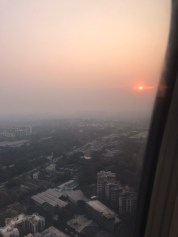 At the airports, it’s always the airplanes from these countries of brown people that get parked out at the periphery of the airports, shuttle bussed in. Advertisements in India and Mexico, always feature light skinned people, and all the soaps and face creams in India are “lightening.” The fancy ads in Paris and Amsterdam seem to sell the idea of whiteness more than any particular product. All these subtle racisms weave into our reality often unchecked, and perhaps somehow make the larger more striking and systemic injustices possible by permeating our minds with a pervasive subconscious message: devaluing, dehumanizing. As uncomfortable and disorienting as it is, the incredible privilege of international travel can sure shake loose the grip of dullness and complacency.
At the airports, it’s always the airplanes from these countries of brown people that get parked out at the periphery of the airports, shuttle bussed in. Advertisements in India and Mexico, always feature light skinned people, and all the soaps and face creams in India are “lightening.” The fancy ads in Paris and Amsterdam seem to sell the idea of whiteness more than any particular product. All these subtle racisms weave into our reality often unchecked, and perhaps somehow make the larger more striking and systemic injustices possible by permeating our minds with a pervasive subconscious message: devaluing, dehumanizing. As uncomfortable and disorienting as it is, the incredible privilege of international travel can sure shake loose the grip of dullness and complacency.
As soon as I arrived in Pune I jumped in and felt an immediate connection amongst the 1300 students gathered from 56 countries who had come to connect and learn, and celebrate Guruji’s life. The event was so impressive, the stadium adorned with massive glowing pictures and quotes of BKS Iyengar, his presence palpable. Abhijata, Prashantji, and Geetaji along with an incredible crew of volunteers and special guests pulled of something massive and wonderful. I can’t even begin to convey the powerful teachings and connections that unfolded. Although the group was so huge – so many different languages flowing all around – there was a true sense of intimacy, camaraderie, and connection amongst everyone there, from legendary senior teachers to newbies to the Iyengar family who were held in sacred reverence and at the same time, were just right there, playing with the kids, part of it all.
(Nearly all the beautiful photos of the Centenary Intensive were taken by Shael Sharma, thank you Shael!! See more on the Iyengar Yoga FB page.)
There was a tribute show for Guruji being organized, and I knew I wanted to be part of that, so despite intense jetleg, the first full day I was there I journeyed down into town to get art supplies. The tiny art shop I found was so jam packed and small I couldn’t even stand up in the upper story where the paints were, but there were sweet helpers who new just where everything was tucked away amidst the intricate stacks and shelves that filled every nook and cranny (who were much shorter than me) and I got the art supplies! India… There’s just no words for the intensity, density of sensation, and within it, something that wins me over again and again. A spirit of vital essence, endurance. Something indescribable. I loaded my backpack full of paints and brushes, ordered a large board to paint on for delivery the following morning, and felt ready for the show the next day. The board was several hours late being delivered, however, and when the show was about to start (classical Indian and Chinese dancers in sparkling costumed finery, bustling around nervously) I still didn’t have anything to paint on. I was at a loss. I gave it over to God to decide if it was meant to be, it was out of my hands, I’d done all I could. I let it go.
And THEN this young sweet new yoga friend named Prashant who was helping with the event and also an artist learned about the fix I was in. He had saved some salvaged materials from a previous event (perfect, I was wishing I could re-purpose something laying around!) and brought out a huge stretched “canvas,” just in time for the show to begin! We later joked Saraswati was at work.
I painted furiously, busting through a block I’ve had for the last few years around painting. With 1000 folks witnessing, I painted Guruji in Natarajasna at the base of the stage while the other performers danced, puppeteered, read poetry, and busted out capoeira. I had no time for thought, for self consciousness. It was all bhakti. All love. It was a treat to make such an offering. The painting became a conduit for many simple moments of friendship with many folks from many countries. Towards the end of the Intensive, a special surprise – I was brought back to a small room with Abhi and Zubin, and we held it up; Geeta was pleased with the painting and signed it, ‘All the the best wishes, Geeta S. Iyengar.’ I thought for a moment of keeping it but it felt right to let it live on as a gift to the Iyengars. So, it will have it’s own continued adventure at a new Iyengar center in Mumbai.
The teachings were of course, profound.

Prashant taught the first 5 days, Geetaji the second. Asana and Pranayama lessons, rich with mind inverting philosophy, filled the mornings. After lunch (fresh coconuts, anyone?) afternoons of moving talks by Abhi, Geetaji (on her birthday!) or Prashantji or lively interactive sessions exploring the future of mentorship, assessment, and how global Iyengar Yoga culture. These afternoon sessions stirred my heart. I am not a person who cries often, but tears were often close to the surface, I was so moved. Over and over. Layers and layers of tender meaning emerged over these full, rich days.
One morning, they brought in a mass of children, (here is one instance where the floodgates opened; missing my own kids, I had tears rolling down my cheeks for most of this class) and we all practiced children’s yoga: wild jumpings, up, down! We learned the proper way to bow in prostration. Another day, after a long sirsasana (headstand) one of Guruji’s dear friends from Mumbai, a student of many decades who is now 101 years old, came and with assistance whipped up into his own long held supported headstand, and then came down after a time to share a beautiful message. The feeling of family was woven in so many ways throughout the event.
The Iyengar family on Guruji’s birthday
Geetaji said of the buttocks in virabhadrasana 2 to pull it in close, like it’s your baby. Even if you are tired you must still tend to that baby, ‘don’t leave it out of the family photo!’ Prashantji taught how we are a child of the breath, and yet the breath is our child, too… and like a child who needs not only food, water, but love and delight, to be played with, our breath too needs to be delighted in, played with. He shared how when they were young children they would jump on and climb around on their father, as children do, and Guruji would do his poses (setu bandhasana, urdhva dhanurasana!!) with the kids balancing on top. He didn’t send hem away, he would incorporate them and explore, play.
Geetaji spoke of her mother Ramamani, who was also one of her Gurus and taught her so much about the path of yoga, and how to practice as a woman. Guruji would be busy with his students and so didn’t give special attention or teachings to his children, but her mother would advocate for Geeta as she learned asana.
Just as people often have a very different relationship with their kids than they do with their grandchildren, it’s moving how Guruji took Abhijata under his wing, so lovingly, sharing so much. Abhi is so smart, hard working, devoted, humble, and — has such a good sense of humor! She can see reality clearly. Can’t WAIT to study with her at the 2019 USA Iyengar Convention in Dallas!) I loved hearing stories of how Abhi’s dad would bring in her baby to the practice hall while she was practicing, and Guruji would take the baby and absolutely delight in putting the little one into various yoga shapes. The ways the Iyengar family expresses their very human, very real devotion and love of Guruji is so inspiring. I shared a small speech at one of the afternoon sessions, how Guruji’s light is so bright like the sun, and that like New Mexican moonlight on a clear night, that light continues to shine, spread all over, through his direct disciples and the myriad of practitioners. Afterwards, one of his daughters greeted me, happy with the metaphor. This element of family was moving to me, and made the part of me that is a mother feel included and valued. Sometimes parenting and serious yoga practice feel in conflict with eachother. Moving beyond that duality is a continual part of my journey.
The asana and pranayama classes were a vibrational transmission of tremendous resonance.
As much as Prashantji drove us to dive into what Iyengar did within himself, beyond what he did out in the world – Iyengar’s yoga, rather than Iyengar Yoga – there was a strong emphasis on inclusion. Just as different people digest food differently, or have a different experience based on their longitude/latitude, there are many different takes on Guruji’s teachings and they’re all valid, if truly ‘Iyengar yoga is for everyone.’ His journeys into the subtle opened up vast inner terrain. When we look at the stars, we look with awe. Nothing to fix, to own. Can we look inside like that, in awe? Practice with an explorers mind, not a conqueror’s mind?
Then Geetaji, a force of nature, vibrant and fierce. Going beyond where I’ve ever gone before in asana practice, I was one tiny person in the crowd, but like so many, I felt she was teaching exactly for me. She was brilliant: intense generosity and generous intensity! She required us to repeatedly go beyond the limitations of our dullness, fear complex, mind, ego. To understand, ‘where have I been conditioned?’

In a 20 minute sirsasana she drove us not to come down, to persevere, ‘you think you will die?! It’s not so easy to die!’ Every instruction penetrated through multiple layers: were the physical actions a metaphor for breaking down klehsas, or was purifying accumulated klesha layers a metaphor for physically going deeper? Lift, lift, LIIIIFT! All metaphor disappeared; all was live, real, electric, awake. I was in total reverence, love. (Even though she said to put our love into the sutras, not her)… Surrender. A deep dose. A profound awakening. A devotion in motion.
There’s SO much more I could write, but then this already too long poast will never be shared, and already the river of time has pulled us around the bend of these events.
The night before Geeta passed away I attended an incredibly lavish birthday dinner for Garth, a magical senior teacher. There were such inspiring legendary teachers from many countries in attendance, I felt alive in every cell. Willamarie, your are an angel! So many amazing, honest, beautiful connections. I stayed near the Institute that night, and when I heard the news the next morning was shocked, my heart stilled. The small balcony at Hotel Chatuk was just big enough for a yoga mat, I practiced, and ah it felt so crisp, clear, different. I packed up my things with a chocked, silent mind. Went to buy a flower, and walked to RIMYI where seemingly a thousand shoes were left at the gate.
Who am I to have been swept in, to this beloved circle? To be gently ushered in, hands on my back, sweet sad faces that have become familiar and so dear. Stepping into receive the prasad, the presence, my kiss to her feet wrapped in pure white, hot tears rolling, heart wings beating inside my ribcage. Profound gratitude. Timeless time. Flowing out of the house, carried by an unseen river. Deposited into the gathered crowd, beautiful and with wet eyes, tender presence, all grateful for the tremendous life and rich teachings of this noble, fierce, devoted and brilliant woman. All of us carefully squeezed into that small patio outside the Iyengar family’s house. Prayers and incense, chanting and tears, flower petals, rice. I moved further and further back, absorbing it all in. After the men of the family carried her out, I walked back, and went to the airport to fly home. How could have known I would travel around the world to receive Geetaji’s teachings, and be there somehow to attend her passing?
Practice since feels different. A much greater responsibility, ripe potential, and joy – all simultaneously pressing.
My heart feels the pulse of a deeper rhythm, a deeper meaning. The finality of death. In Mexico, Zoreh taught one day, how in Iranian culture they say always keep the bird of death sitting on your shoulder, a reminder we don’t have unlimited time here; how cultures that avoid reckoning with death that keep it tucked away, become shallow. I feel the urgency that death brings, to live fully. The preciousness of life and the drive to practice. To make best use of the time here, embodied. To take the steps the earth needs from me, the work of justice and accessibility within my yoga world. My children, growing so fast, demanding so much. My unspeakably wonderful partner…so much to balance in life – So fleeting. And Yoga, so magnificent an opportunity. Geetaji was clear that her path was for yoga. How can I practice in a way that is worthy of her teachings? What an incredible honor to have been here. To have made this precious contact.
Writing this out is settling, helps me realize it’s really happening. A life I dreamt of, and have worked for, for so long. It’s amazing thing to have my heart dreams materialize, manifest. To be a certified Iyengar teacher, teaching in diverse settings and communities, traveling to India to study, with a beautiful partner, and wonderful children. Still, there’s so much barely straggling along in my life, the press of my many failures and the mundane, and I wonder in a world so full of sorrow, injustice, tragic changes, unprecedented destruction, is there space for celebrating my small experiences of real magic? We are here to live, to love and serve. I’m beyond grateful for how it’s all unfolding, and that you are part of it with me.







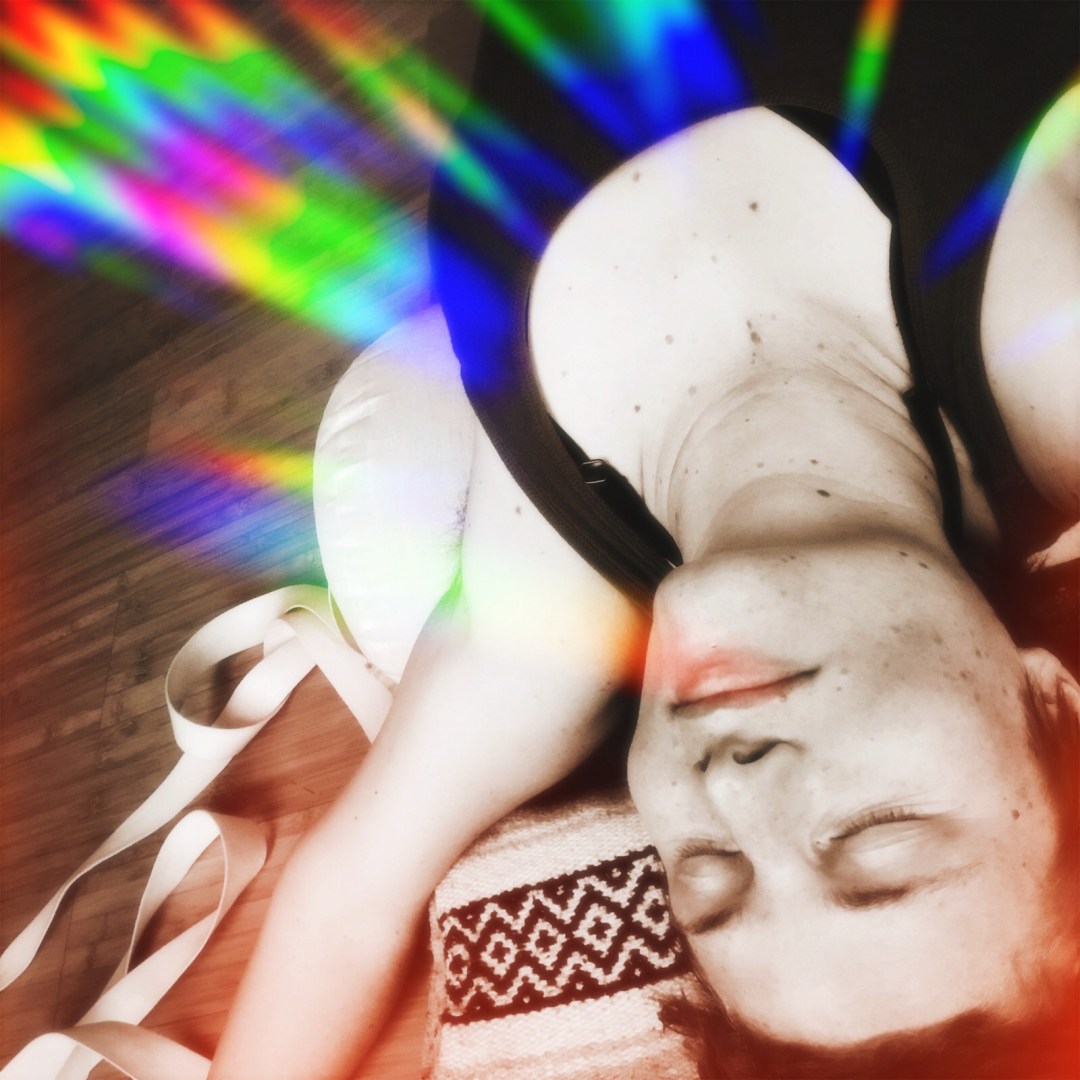






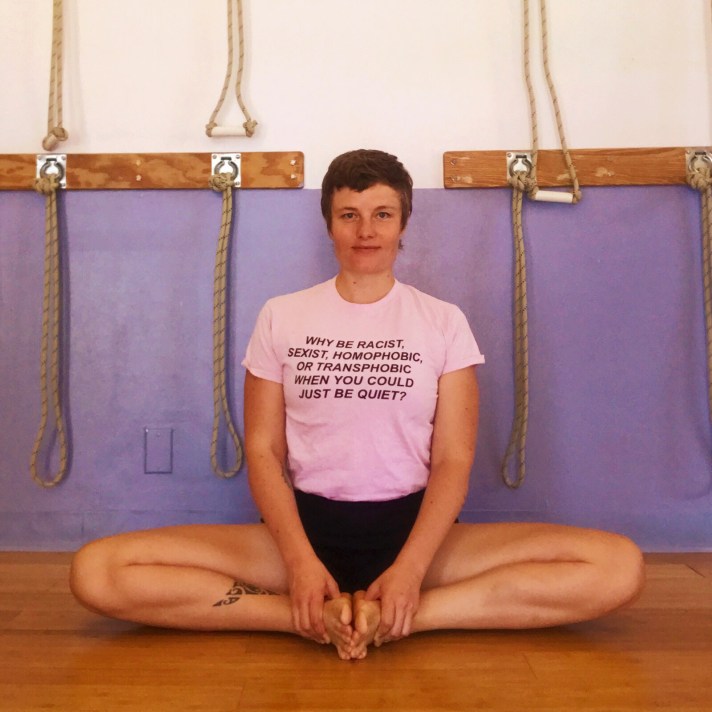
 In Core of Yoga Sutras he describes these four qualities to correlate to the four chambers of the heart. He says Patanjali has dealt with the “four biological chambers of the heart as four facets of emotional intelligence.” He also references sutra 1.17 as describing the four lobes of the brain, which when in balance and co-ordinated, “there arises right synthesis, leading to correct judgement. From this …one experiences a state of bliss, nullifying the divisions of the brain and the feeling of “I.” As the feeling of “I” fades, a pure state of just ‘beingness’ is felt without any expression. He says of Sutras 1.17 and 1.33, that those two sutras opened his thoughts, “enabling me to understand the necessity for balance, harmony, and concord between the intellect of the head and the intelligence of the heart.”
In Core of Yoga Sutras he describes these four qualities to correlate to the four chambers of the heart. He says Patanjali has dealt with the “four biological chambers of the heart as four facets of emotional intelligence.” He also references sutra 1.17 as describing the four lobes of the brain, which when in balance and co-ordinated, “there arises right synthesis, leading to correct judgement. From this …one experiences a state of bliss, nullifying the divisions of the brain and the feeling of “I.” As the feeling of “I” fades, a pure state of just ‘beingness’ is felt without any expression. He says of Sutras 1.17 and 1.33, that those two sutras opened his thoughts, “enabling me to understand the necessity for balance, harmony, and concord between the intellect of the head and the intelligence of the heart.”





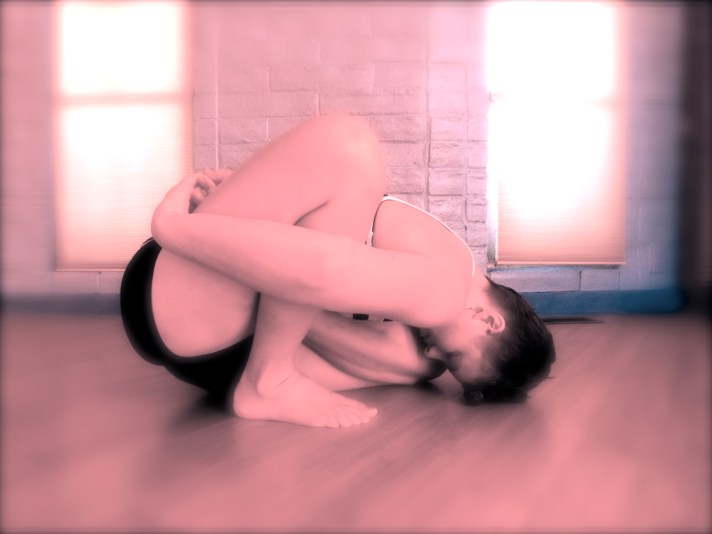


 I have experienced that the deepest source of clarity, peace, motivation, resilience, and will power to be this connection and sublimatio
I have experienced that the deepest source of clarity, peace, motivation, resilience, and will power to be this connection and sublimatio Just as the momentum in our physical bodies and minds are hard to see and feel at first, because they are so familiar, the destructive patterns in our shared world can be difficult to see, especially by those on the receiving end of certain privileges that come with moving through the world as white, cis gendered, etc. One of my teachers, a long time physical therapist, Patti Lentz often says “we default to the known, and we get good at what we practice.” The decision to look squarely and compassionately at our weakest, most imbalanced parts is key for true healing and integration. This is where these deeper definitions of yoga are very powerful.
Just as the momentum in our physical bodies and minds are hard to see and feel at first, because they are so familiar, the destructive patterns in our shared world can be difficult to see, especially by those on the receiving end of certain privileges that come with moving through the world as white, cis gendered, etc. One of my teachers, a long time physical therapist, Patti Lentz often says “we default to the known, and we get good at what we practice.” The decision to look squarely and compassionately at our weakest, most imbalanced parts is key for true healing and integration. This is where these deeper definitions of yoga are very powerful.
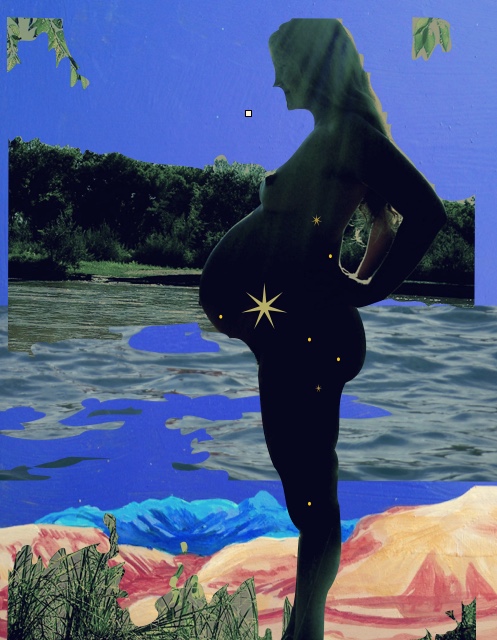

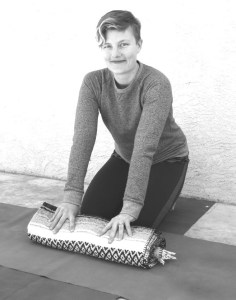


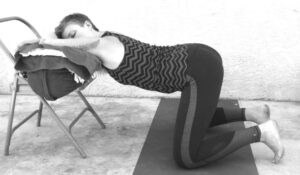 You can support yourself in labor by resting the head, arms, and chest forward on a soft sturdy support, such as a bed. When the hands are on the floor, be sure to keep the base of the tigers heavy, wrists light. This is also a wonderful pose for encouraging optimal birth position.
You can support yourself in labor by resting the head, arms, and chest forward on a soft sturdy support, such as a bed. When the hands are on the floor, be sure to keep the base of the tigers heavy, wrists light. This is also a wonderful pose for encouraging optimal birth position.





 b. Parigasana
b. Parigasana Sound: Looooong and Low:
Sound: Looooong and Low: e. Pelvic Floor Stretch:
e. Pelvic Floor Stretch: f. High lunge:
f. High lunge:
 Back to HANDS AND KNEES, hip circle, observe if hips feel better, then take a down dog, or rest in child’s pose.
Back to HANDS AND KNEES, hip circle, observe if hips feel better, then take a down dog, or rest in child’s pose.

 Squatting is a great way to amplify the downward pressure and effectiveness of contractions during labor; you can squat with support, such as on a toilet seat, a small birth ball, or leaning forward resting the chest, arms, and head on a soft chair or bed.
Squatting is a great way to amplify the downward pressure and effectiveness of contractions during labor; you can squat with support, such as on a toilet seat, a small birth ball, or leaning forward resting the chest, arms, and head on a soft chair or bed. Squatting is a great way to amplify the downward pressure and effectiveness of contractions during labor; you can squat with support, such as on a toilet seat, a small birth ball, or leaning forward resting the chest, arms, and head on a soft chair or bed.
Squatting is a great way to amplify the downward pressure and effectiveness of contractions during labor; you can squat with support, such as on a toilet seat, a small birth ball, or leaning forward resting the chest, arms, and head on a soft chair or bed. 6. Utkata Konasana:
6. Utkata Konasana:


 7. Prasarita Padotonasana: Expanded Legs Forward Bend: To practice this pose, the feet are parallel, heels separated about as wide as the wrists when the arms are extended out the side. The sitting bones lift and broaden, the pelvis rotates forward around the thigh bones, so the front spine can extend. Keep the heels heavy, reaching the tailbone back behind the heels, as you lengthen forward through the spine, crown of the head, and arms. Take enough height so that the front body is spacious. As you forward bend on the chair: push chair forward, draw tail back… HEELS HEAVY. You can stretch the mat wider between the feet isolmetraically to broaden the inner pelvis and stretch the pelvic floor, or press the outer legs in medially, as though you would slide the legs towards each other, to help draw the sacrum in, and stabilize. If you are familiar with both actions, do both at once!
A good way to use this pose for relieving low back pain, try practicing it on a kitchen counter throughout the day.
This can be a great labor pose when leaning the upper body (chest, arms, and head) forward onto a high bed or soft padded counter. As a yoga pose it helps strengthen the legs and increases circulation to the reproductive organs, while also lengthening and releasing the lower back.
7. Prasarita Padotonasana: Expanded Legs Forward Bend: To practice this pose, the feet are parallel, heels separated about as wide as the wrists when the arms are extended out the side. The sitting bones lift and broaden, the pelvis rotates forward around the thigh bones, so the front spine can extend. Keep the heels heavy, reaching the tailbone back behind the heels, as you lengthen forward through the spine, crown of the head, and arms. Take enough height so that the front body is spacious. As you forward bend on the chair: push chair forward, draw tail back… HEELS HEAVY. You can stretch the mat wider between the feet isolmetraically to broaden the inner pelvis and stretch the pelvic floor, or press the outer legs in medially, as though you would slide the legs towards each other, to help draw the sacrum in, and stabilize. If you are familiar with both actions, do both at once!
A good way to use this pose for relieving low back pain, try practicing it on a kitchen counter throughout the day.
This can be a great labor pose when leaning the upper body (chest, arms, and head) forward onto a high bed or soft padded counter. As a yoga pose it helps strengthen the legs and increases circulation to the reproductive organs, while also lengthening and releasing the lower back.



